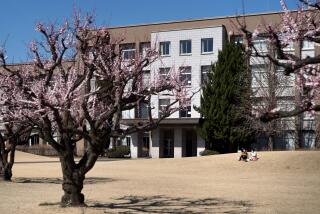New Trade Imbalance: Research : Japanese Far Outpace Americans in Scientific Study Trips
LA JOLLA — When Craig T. Van Degrift, a physicist with the U.S. National Bureau of Standards reports to work these days, it’s at the Electrotechnical Laboratory in Tsukuba, Japan.
“There was never another long-term American visitor there before I arrived, and I don’t see any coming in the immediate future,” said Van Degrift. He left Washington last August to spend a year working with a Japanese research team.
Van Degrift’s yearlong sabbatical is unusual: Americans are increasingly visiting Japan for meetings and brief visits, but only “a couple of hundred” U.S. researchers have spent six months or longer working at Japanese research institutions, according to Larry Weber, associate program manager of the National Science Foundation’s U.S.-Japan program.
In contrast, “as many as 5,000 Japanese” researchers are working at U.S. research institutions, said Weber, who along with Van Degrift spoke Monday in La Jolla at a conference sponsored by the NSF and the University of California, San Diego. “We’re talking about a difference measured in orders of magnitude.”
That imbalance is slowly being corrected as various organizations, including the NSF and its Japanese counterparts, increase funding that makes possible visits by U.S. researchers and scientists.
Last year, the NSF funded only “two or three” long-term visits to Japan by U.S. researchers, Weber said. But during the coming year, as many as 200 university, government and industry researchers from the United States will spend extended periods of time at several Japanese research centers, Weber said.
U.S. researchers have benefited from Japan’s recent decision to increase “international” access to the country’s basic research, Weber said. During the past year, the NSF and three important Japanese ministries that oversee much of Japan’s basic research have increased funding for visits by U.S researchers.
Need Financial Backing
Officials in Japan’s leading organizations realize that “there are many things we have to do in the future to promote” U.S. participation in Japan’s research, according to Shoroku Kato, executive director of the New Energy and Industrial Technology Development Organization. “That’s why we came here: To be face-to-face with people, to make it possible for things to happen in the future.”
“Japan’s economic role has put the country into an increasing role as a host for (research-oriented) visitors,” Van Degrift said. “They are terribly conscious of that new role and they’re very proud of it.”
But long-term visitors often need hefty financial backing, said Van Degrift, who traveled to Japan along with his wife, Marilyn, and their two young daughters. The NSF and a Japanese agency that oversees basic research combined resources to help cover the Van Degrift family’s average monthly bills of $3,200 and one-time expenses that have hit $11,500.
Even in Tsukuba, a farming town, expenses run high, according to Van Degrift, whose daughters are attending Japanese schools.
“The transition from the U.S. credit economy to the Japanese cash economy can be a difficult one,” Van Degrift said. “You should assume that the Japanese price is 2 1/2 times the U.S. price for anything except for cars, peanuts (and) gardening gloves . . . which are basically the same price as in the U.S.”
While it will be expensive to fund long-term research program in Japan, “We’ve got to get on the ball and go with this kind of exchange,” said Van Degrift, who researches conductivity. “My primary goal in Japan is to study the Quantum Hall Effect, and that’s far too complicated to cover in just a week.”
Monday’s session in La Jolla included presentations by leaders of the New Energy and Industrial Technology Development Organization and the Agency for Industrial Science and Technology, two subsidiaries of Japan’s Ministry of International Trade and Industry.
“(The La Jolla meeting) was really the first such effort where a group of Japanese scientists came (to the U.S.) to explain” their research programs and goals, Weber said.
During the coming week, Kato and other Japanese officials will appear at similar forums at the Massachusetts Institute of Technology and the Georgia Institute of Technology.
More to Read
Sign up for Essential California
The most important California stories and recommendations in your inbox every morning.
You may occasionally receive promotional content from the Los Angeles Times.







